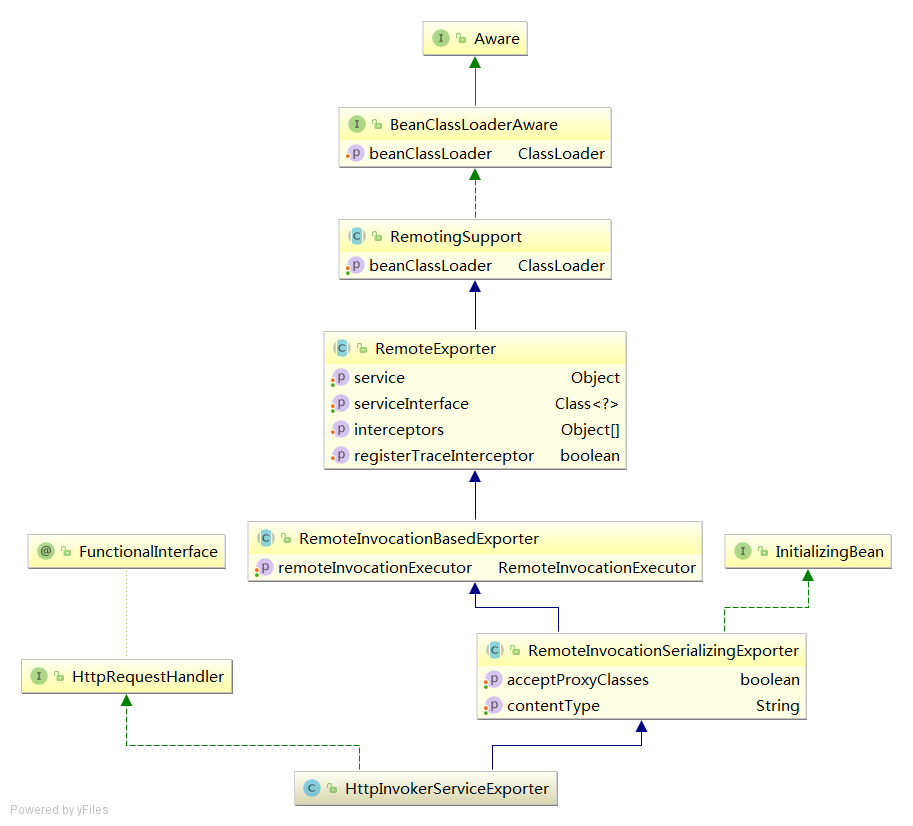Spring HttpInvoker 作为 Spring 家族的一员,作为新的远程调用模型。
主要目的是来执行基于 HTTP 的远程调用(轻松穿越防火墙),并使用标准的 JDK 序列化机制。
Http 远程调用框架不是有成熟的 Hessian、Burlap嘛,Spring 团队为什么还要重复造轮子呢?
是因为他们有各自的序列化方式,当数据类型比较复杂时私有的序列化方法可能会无法胜任。
1.项目实战

分为 server 服务和 api 接口模块,api 模块打包方式为 jar,其中定义对应传递 BO 和接口。
server 模块打包方式为 war,为业务核心服务,进行业务逻辑。
接口定义如下:
- public interface UserService {
- /**
- * 通过ID获取用户
- *
- * @param uuid 用户ID
- * @return 用户实体
- */
- User getUserById(String uuid);
- }
接口返回的业务实体属性,还需你根据具体业务拿捏,实现类:
- public class UserServiceImpl implements UserService {
- @Override
- public User getUserById(String uuid) {
- User user = new User();
- user.setUuid(uuid);
- user.setName("Orson");
- user.setPasswd("xyxy");
- user.setSex("F");
- user.setPhone("13974856211");
- user.setPhoto("/photo/user/xyxy.gif");
- user.setEmail("954875698@qq.com");
- user.setCreateBy("orson");
- return user;
- }
- }
Spring 配置服务如下:
- <bean id="userServiceImpl" class="com.rambo.httpinvoker.server.impl.UserServiceImpl" />
-
- <bean id="userServiceInvoker" class="org.springframework.remoting.httpinvoker.HttpInvokerServiceExporter">
- <property name="service" ref="userServiceImpl" />
- <property name="serviceInterface" value="com.rambo.httpinvoker.api.UserService" />
- </bean>
-
- <bean class="org.springframework.web.servlet.handler.SimpleUrlHandlerMapping">
- <property name="mappings">
- <props>
- <prop key="/userService">userServiceInvoker</prop>
- </props>
- </property>
- </bean>
web.xml 配置:
- <servlet>
- <servlet-name>service</servlet-name>
- <servlet-class>org.springframework.web.servlet.DispatcherServlet</servlet-class>
- <init-param>
- <param-name>contextConfigLocation</param-name>
- <param-value>classpath:spring-httpinvoke-server.xml</param-value>
- </init-param>
- <load-on-startup>1</load-on-startup>
- </servlet>
-
- <servlet-mapping>
- <servlet-name>service</servlet-name>
- <url-pattern>/service/*</url-pattern>
- </servlet-mapping>
启动服务模块,这时服务就已经发布成功了,是不是很简单?
客户端将 api 依赖进去,spring 稍做下配置即可以在客户端中使用对应的服务。
- <!-- 客户端使用 HttpInvokerProxyFactoryBean 代理客户端向服务器端发送请求,请求接口为 UserService 的服务 -->
- <bean id="userService" class="org.springframework.remoting.httpinvoker.HttpInvokerProxyFactoryBean">
- <property name="serviceUrl" value="http://${server.url}/service/userService"/>
- <property name="serviceInterface" value="com.rambo.httpinvoker.api.UserService"/>
- </bean>
demo 项目地址:https://gitee.com/LanboEx/rmi-demo.git
2.源码分析
源码分析时从客户端和服务端配置两个对象 HttpInvokerServiceExporter、HttpInvokerProxyFactoryBean下手。

HttpInvokerServiceExporter 继承 HttpRequestHandler 并实现 handleRequest 方法。
- public void handleRequest(HttpServletRequest request, HttpServletResponse response) throws ServletException, IOException {
- try {
- RemoteInvocation invocation = this.readRemoteInvocation(request);
- RemoteInvocationResult result = this.invokeAndCreateResult(invocation, this.getProxy());
- this.writeRemoteInvocationResult(request, response, result);
- } catch (ClassNotFoundException var5) {
- throw new NestedServletException("Class not found during deserialization", var5);
- }
- }
首先从 http 请求中读取远程调用对象,然后调用服务对应方法并组织执行结果,最后将执行结果写入到 http 返回。
这几个过程你追溯到底层代码,你会发现 Java ObjectInputStream 反序列化对象、Java Method 反射对象。

HttpInvokerProxyFactoryBean 实现 FactoryBean 接口并继承 HttpInvokerClientInterceptor,spring ioc 托管该类并初始化对应属性后返回该类代理。
- public void afterPropertiesSet() {
- super.afterPropertiesSet();
- if (this.getServiceInterface() == null) {
- throw new IllegalArgumentException("Property 'serviceInterface' is required");
- } else {
- this.serviceProxy = (new ProxyFactory(this.getServiceInterface(), this)).getProxy(this.getBeanClassLoader());
- }
- }
注意获取代理类时传入的拦截器参数为 this 即为父类 HttpInvokerClientInterceptor。
该拦截器 invoke 方法首先进行远程调用对象的封装,其次发起远程服务请求,最后解析返回结果并封装返回。
追溯这几个过程的时候你会看到,Sprng 代理对象 ProxyFactory、Java 序列对象 ObjectOutputStream、Java Http 连接对象 HttpURLConnection。
HttpInvoker 调优时也记得去关注上述几个对象:https://blog.csdn.net/qian_348840260/article/details/51555864
从服务暴露到服务调用,debug 源码过来底层总是那些熟悉的面孔,只不过 Spring 团队做了出色的封装和合理的抽象。
- public Object invoke(MethodInvocation methodInvocation) throws Throwable {
- if (AopUtils.isToStringMethod(methodInvocation.getMethod())) {
- return "HTTP invoker proxy for service URL [" + this.getServiceUrl() + "]";
- } else {
- RemoteInvocation invocation = this.createRemoteInvocation(methodInvocation);
- RemoteInvocationResult result;
- try {
- result = this.executeRequest(invocation, methodInvocation);
- } catch (Throwable var7) {
- RemoteAccessException rae = this.convertHttpInvokerAccessException(var7);
- throw (Throwable)(rae != null ? rae : var7);
- }
- return this.recreateRemoteInvocationResult(result);
- }
- }